When Taylor Swift dropped her 10th studio album on October 21, 2022, Midnights instantly became the #1 album in the country, according to the Billboard 200.
The lead track “Anti-Hero” became the most added song on CHR, Hot AC, and AC radio.
It was even the top selling album on Vinyl for its debut week. In fact, Midnights sold more LPs in one week than any other album this century.
Par for the course for Tay-Tay.
What is earth-shattering is the feat Taylor Swift achieved with her new album that music geeks have deemed impossible since April of 1964: she made Billboard Hot 100 history as the very first artist ever to occupy all of the Top 10 slots on the Billboard Hot 100.
In recent years, however, music experts have assumed a Top 10 takeover was inevitable. Drake almost did it in 2021.
How did the impossible become the inevitable? Why Swift? And for those of us in radio programming, what does Midnights teach us about how listeners consume new music today?
Of course, it involves streaming. But perhaps not for the reasons you think.
To understand how Taylor is altering the universe, let’s examine how Swift’s album drop impacted what U.S. Spotify users played.
Below are the Top 25 most-played songs on Spotify in the U.S. for the week of October 20th, 2022, the week before Midnights debuted. Harry Styles, Bad Bunny, and Drake are predictably there. Steve Lacy and Zach Bryan’s archetype-defying hits are there, too.
When Swift released the 13 tracks on the physical CD of Midnights—along with the additional 7 tracks on the Midnights 3am Edition online—those 20 tracks immediately pushed all but five of last week’s most-streamed songs out of Spotify’s Top 20 for the week of October 27th:
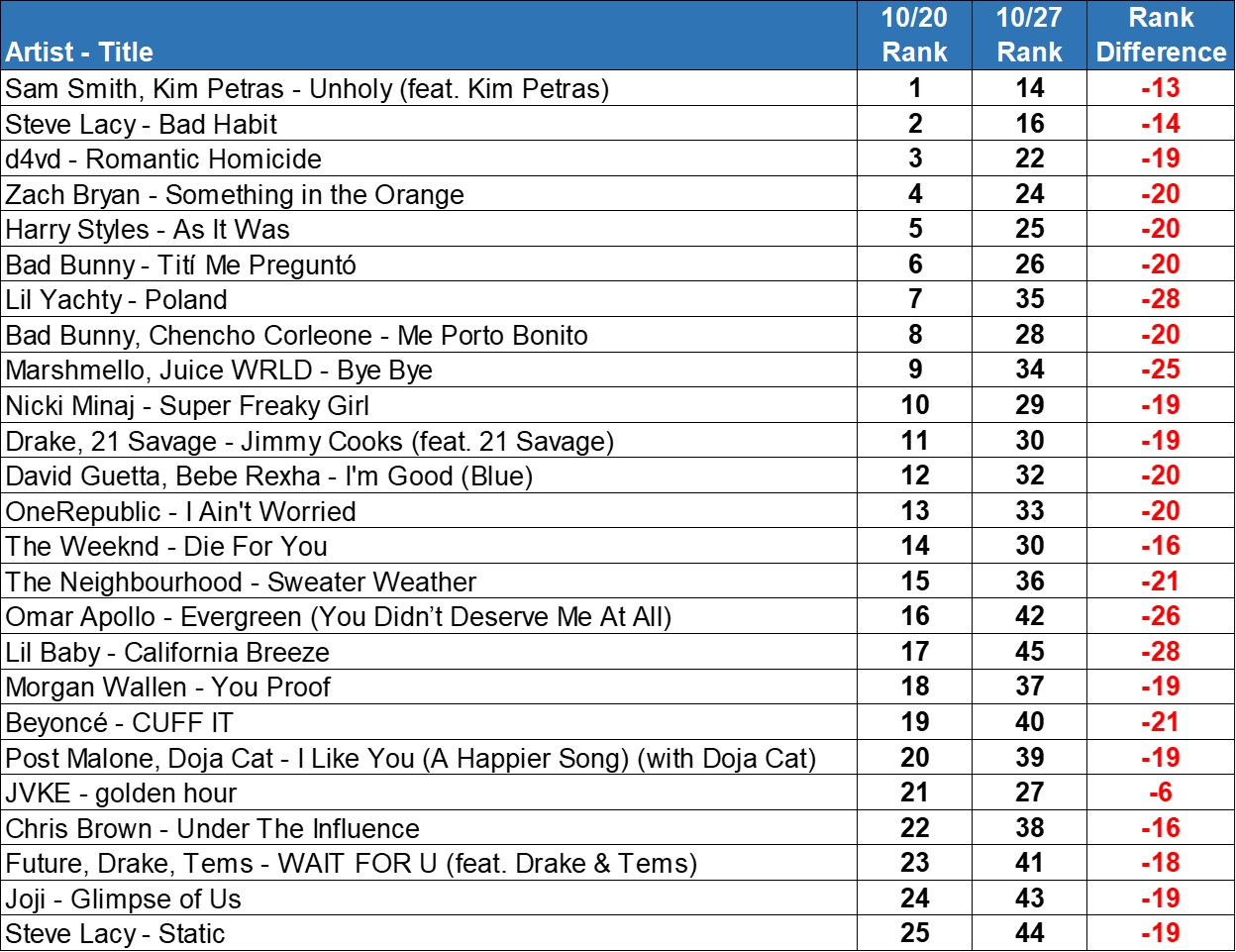
Spotify’s Top 25 songs the week before Midnights debuted dropped 19 rank positions the week when Swift released Midnights.
“Wow,” you’re thinking, “everyone instantly lost interest in whatever songs they were streaming to go listen to Taylor’s Swift’s new songs!”
Except that’s not at all what happened.
Here’s a chart showing the actual number of times each of those songs played on Spotify pre- and post-Taylor:
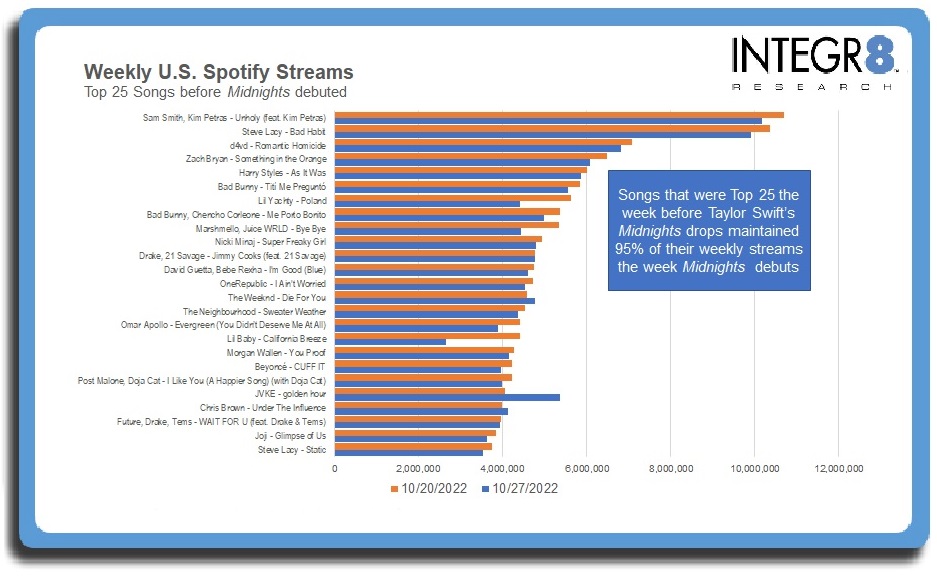 While Taylor’s streaming number dwarfed previously released tracks, plays for non-Taylor titles remained largely unchanged.
While Taylor’s streaming number dwarfed previously released tracks, plays for non-Taylor titles remained largely unchanged.
Generally, songs saw their week- to week Spotify play counts drop about 5 percent, which is exactly what most big hit songs on Spotify see. As much as some employed by CHR radio stations may have hoped, listeners kept right on streaming “As It Was” as if nothing happened.
Instead, what Taylor Swift did was create brand new streaming sessions on Spotify:

Taylor Swift’s Midnights did not diminish listening to other artists, but instead created new listening occasions.
How big was this impact? The total plays for the Top 25 songs of the week on Spotify were almost three times higher the week of Taylor’s debut compared to the previous week.
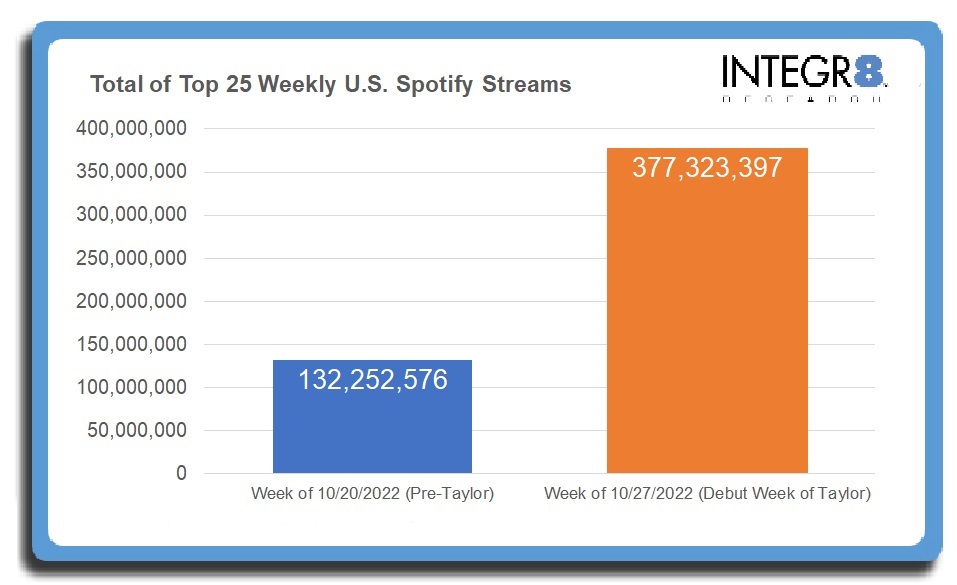
As with most problems, we need to start not with how we as industry insiders evaluate music, but instead with how real listeners consume music.
THE OLD WAY AN ALBUM DEBUTS
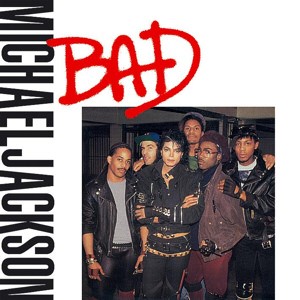
It’s Wednesday, September 2nd, 1987. Michael Jackson’s long-awaited new album is out and ever since you saw the “Bad” video on that “Michael Jackson: The Magic Returns” TV special Monday night, you’ve pestered your parents to get it.
Today they relent. You slap on your Swatch, hop in the Cutlass, and head to Northdale Mall, where you buy one of the 2.25 million copies of Bad that Americans will snap up this week. Your cassette purchase helps make Bad the #1 album. It will stay #1 for six weeks as various Americans pick up the album at Record Bar, Sam Goody, and K-Mart.
At home, you pop the tape in your boombox and listen straight through several times, hearing “The Way You Make Me Feel”, “Man in the Mirror”, and “Smooth Criminal” for the first time.
In coming months, a record-breaking five songs from Bad would become #1 hits. However, those songs became hits based on how many people bought the 45s (or Cassingles) and how often Z100 and Kiss-FM played those songs. Given the record and radio industry’s tradition of releasing singles sequentially, you heard most of those songs on the album months before casual fans did.
Since you already own the whole album, however, you never bought those singles. The music industry has no way to capture that you, an active consumer of Michael Jackson’s music, rewind for “Dirty Diana” and fast-forward past “Man In The Mirror.” Your one album purchase is your one vote.
THE NEW WAY AN ALBUM DEBUTS
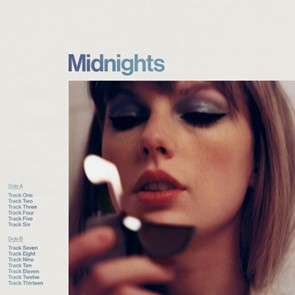
It’s Saturday morning, October 22nd, 2022. You grab your phone, open Spotify, and search “Ta…” That’s all it took to take you to Midnights (3am Edition), the new project from Taylor Swift. You’ve been waiting for this day ever since she announced the new album on the MTV Music Awards in August. You watched her TikTok where she revealed the track list in September.
Now, it’s finally here.
You start at the top, determined to just play the album straight through, but you remember there’s a track with Lana Del Ray, so you skip to “Snow On The Beach.” Ultimately, you do play the whole album straight through—so many times, in fact, that you lose track that weekend.
Ultimately, you find yourself skipping back to replay “Anti-Hero” and “You’re On Your Own, Kid.”, which you later add to your “Taylor Favorites” playlist.
Unbeknownst to you, Spotify is tracking every track you play, every time you play it. Every time you play a track—even if on auto-repeat—is a vote for that track on the Spotify charts, which in turn feed the information Luminate aggregates to inform music executives and radio programmers.
1987 vs. 2022
Both our Bad buyer and Midnights streamer:
- Eagerly anticipated new music from a beloved artist
- Accessed the album as soon as they could
- Carved out extra time to listen to the debut
- Sampled every song on the album multiple times
- Ultimately came to prefer a few specific songs
From the music fan’s perspective, the only real change is the investment to access the album: Our King of Pop fan had to wait a couple of days for a ride to the mall and have enough money to pay for it. Our Queen of Codependence fan merely had to wake up.
Additionally, that Michael Jackson fan also loved Def Leppard, but passed on Hysteria, 1987 allowance money being what it was. In contrast, our Taylor fan also binged Lainey Wilson’s latest. $9.99 to Spotify covers the entire month.
The transition from purchasing physical media to renting streaming access has dramatically increased the amount of music a typical consumer can access.
The real change, however, is how we track it.
STREAMING CAPTURES “MISSING” ALBUM TRACK FANDOM
Had we had methods to track CD and Cassette tracks played during those waning Cold War days, we may well have discovered that many tracks on Bad were among the most-played songs in the U.S.A. during that first week in September. One vote on the album sales chart would suddenly count for hundreds of plays on the streaming chart.
Conversely, if Spotify only reported the number of individual people who accessed a specific album in the course of the week, we would never know that “Anti-Hero” is played twice as often as “Sweet Nothing.” Using old-school metrics, Taylor would merely have a #1 album until radio airplay gave her a #1 single.
That’s why it’s only been a matter of time that someone would own the Top 10 ever since song streaming eclipsed song sales.
Hip Hop icons, notably Drake, have come close, but it took an artist with the large and demographically broad appeal of Taylor Swift, coupled with streaming becoming common among a large and demographically broad consumer base, to finally command all 10 of America’s most popular songs in a single week.
Had Spotify existed in 1987, Michael Jackson was undoubtedly big enough to accomplish the same feat.
The one factor would have doomed it? Bad only has nine tracks.
WHAT TAYLOR’S FEAT MEANS FOR RADIO
- Streaming has officially triumphed over sales: Streaming already surpassed song sales in the late 2010s for artists appealing to younger listeners, beginning with Hip Hop fans. Now that a broadly appealing artist such as Taylor Swift has dominated Spotify’s most-played songs, that transformation is complete.
- You are now seeing the direct music consumption behavior of an artists’ active fanbase. Binge-playing every track on a heavily anticipated new album has always been a thing. Streaming simply shows us that consumption for the first time. What we used to measure as one album sale is now counted as potentially hundreds of song plays.
- Big album drops create new music listening sessions. Simply examining streaming rank might make you think the appeal of existing songs is tanking. Examining a song’s raw play count, however, reveals that the appetite for existing hits remains relatively unchanged. Binge-listening to new releases is additive.
- To measure how widely appealing a song is, don’t measure how big it is this week. Measure how many weeks it remains big. When an artists’ biggest fans binge-listen to a new release, the tracks’ play counts will be huge—at first. Those songs that grow to appeal to a larger group of casual fans maintain strong streaming counts week after week. Harry Styles’ “As it Was” is still among Spotify’s most played songs after 30 weeks.
